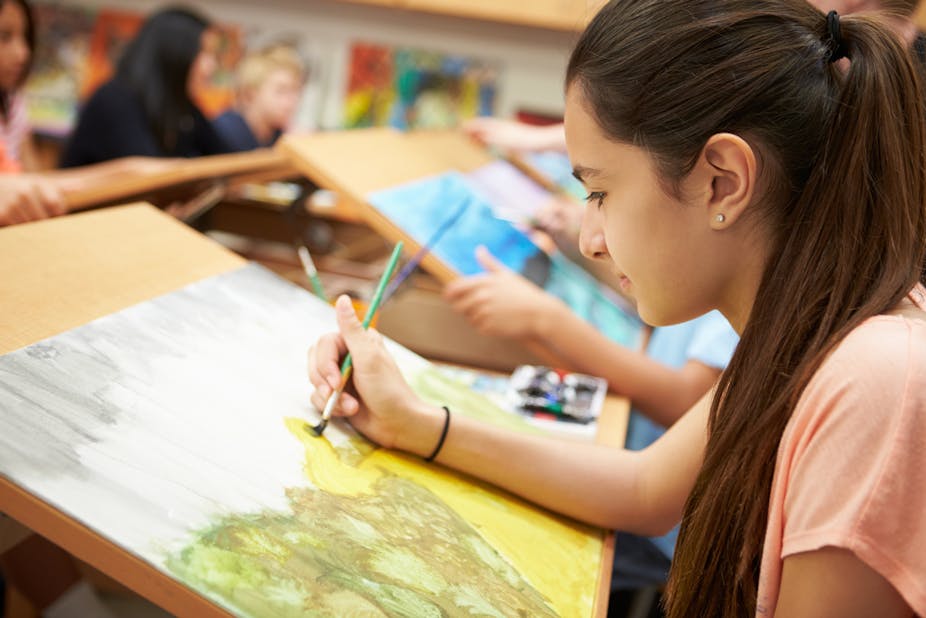The government is pulling simultaneously in two different directions when it comes to how seriously it takes the creative industries. At a speech at the first birthday of the Creative Industries Federation in January, chancellor George Osborne argued that public investment in creative industries was “an investment in who we are as a nation”. He also recognised the importance of “art for art’s sake”.
Yet a month later, a survey of 1,000 teachers reveals how many feel art is being sidelined in the state-school curriculum. A new performance measure called the EBacc, first introduced in 2010, encourages schools to enter students for five core academic GCSE subjects, but as art isn’t one of them it faces decline.
In schools where there had been a reduction in time allocated to art and design, 93% of the teachers questioned in the survey agreed that “the EBacc had reduced opportunities for students to select the subject”. This pattern is being repeated across the creative subjects.
There is also an increasing gap between creative provision in the state sector and independent schools. This is because independent schools do not have to follow national curriculum guidelines. They have an independent inspection system of their own and have far more freedom to choose to do what they think is right for their pupils.
The only possible outcome of this will be a rapid decrease in the number and diversity of young people who are able to envisage a future for themselves in the creative industries. This puts Osborne’s vision for the growth of this UK success story at risk.
Creativity should not be a privilege
This curtailing of the chance for creative encounters in school does not simply limit young peoples’ potential to succeed in the creative sector but more widely in society too. It makes the French sociologist Pierre Bourdieu’s concept of “cultural capital” more pertinent than ever. Exactly 50 years ago, Bourdieu wrote about the importance of a person’s habitus, the social and cultural environment into which we are born, and where we are educated. This determines our ability to develop cultural and social capital, and the impact of this capital on our aspiration and potential achievement.
Successive departments for education since then have tried to find the best way to fill in the gaps left by the very circumstances of birth. But there is compelling evidence in the work of organisations such as Arts Council England, the Higher Education Funding Council and others that we are once again slipping back into a situation where our educational and professional fates are sealed at birth.
The Sutton Trust has also stressed the importance of disadvantaged young people developing advanced cognitive skills to enable them to bridge educational gaps – both in terms of progress in school and admission to “high status universities”.
I have been involved in partnerships between schools, museums and galleries over many years and have seen how creative encounters build these vital cognitive skills – an area that has been the subject of some research. And yet opportunities for this sort of activity are being increasingly restricted, not simply by money, but by the changes to the curriculum that encourage schools to prioritise away from the creative subjects.

I spend a great deal of time working with private schools, given that my subject of art history, according to information supplied to me by the AQA exam board, is now only taught in eight state schools. And I see the differences in creative opportunities for pupils.
Building a creative future
In a 2015 report into the future of cultural value in Britain, The Warwick Commission cited the depressing statistic that children born into low-income families with low levels of qualifications are the least likely to be employed and to succeed in the cultural and creative industries.
At the same time, the government estimates that the global gross value added to the economy by the creative and cultural industries is over £76.9 billion.
While Osborne clearly recognises and values this sector of the economy as a key part of the government’s forward planning, the Department for Education’s current reform agenda seems to be turning its back on the job of nurturing the next generation of creative practitioners and thinkers.
It would be a terrible mistake to allow culture and creativity to become only accessible to those who can pay for it. During times of austerity, it is shortsighted to limit people’s career paths. Instead, we should provide all young people with the confidence, potential and aspiration to achieve whatever future direction they choose to take – this is how we future proof the UK.
As the Warwick Commission report reminds us, an English education system that is not multi-disciplinary, and infused with creativity and enterprise:
Will negatively impact not just on the future of the creative industries, but also on our capacity to produce creative, world-leading scientists, engineers and technologists.
If we focus on the EBacc subjects in isolation, we lose the possibilities produced by a creative ecosystem which equips young people from every background with the skills to think beyond boundaries.

